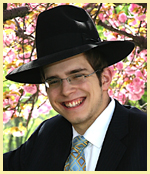Succos 5778
The seven days of Sukkos correspond to the seven Ushpizin: Avraham, Yitzchak, Yaakov, Moshe, Aharon, Yosef, & Dovid. Each of these Ushpizin personify one of the following seven Midos (attributes, and in this particular sequence): Chesed, Gevurah, Tiferes, Netzach, Hod, Yesod, & Malchus. I believe that when we welcome the Ushpizin into our Sukka each night, we should try to focus on that night and day’s Ushpiza’s midah, ensuring that he will truly feel welcome in our Sukka.
DAY 1
Avraham represents Chesed, kindness, which if used properly, makes one be kind and caring to others. The Medrash says that Hashem told Avraham, ‘bicha chosmin’ ‘with you I will finish’. There are a number of explanations for what this means.
In Ikvesa Dimashicha [the last period in Galus before Moshiach arrives], Klal Yisroel will be emulating the Midah of Avraham, i.e. the Midah of Chesed. Look around at all the beautiful organizations involved in Chesed that show how true this is; Vaad Harabonim, Kupat Hair, Mitzva Motivators!, Hatzala, Chaveirim, Shomrim, Bonei olam, Chofetz Chaim Heitage Foundation, Aish, Project Inspire, Bikur Cholim, and countless others along with askanim, and Gemachs for just about everything under the sun.
The Mishna in Avos says that the world stands on three things; Torah, Avodah, and Gemilas Chasadim. The Meforshim tell us that in regards to Torah, we are so far removed from the genuine Torah greatness of the Rishonim and surely of the Amoraim and Tanaim. In regard to the second pillar, Avodah-prayer, we are so far removed from the great Gedolim of just the past few hundred years and surely of generations before that. BUT the last pillar-CHESED- is something that even in this day and age, we can truly emulate. So Hashem told Avraham that Golus will end with his Mida.
By using the above explanation, the Gra answers the following question: Why at the end of Shemoneh Esray in the Yehi Ratzon do we only daven for the rebuilding of the Beis Hamikdash in order that we will be able to truly have a portion in Torah and Avodah, but we don’t daven that then we will be able to fulfill Chesed properly? The answer is that Chesed is something we are able to truly excel in even NOW, in Galus!
This explanation of the Mishna also answers a question that bothered me for a while.
We know that Torah corresponds to Yaakov Avinu, Avodah corresponds to Yitzchak Avinu, and Chesed corresponds to Avraham Avinu. So why is the Mishna in the wrong chronological order?
Maybe the answer is that since the midos of Yitzchak and Yaakov [Avodah and Torah] are midos that we are so far removed from, and only Avraham’s midah of Chesed is one that we can truly excel in, the Mishna put it last since Acharon Acharon Chaviv [the last is most precious]. Or in a different vein, the Mishna put the one that we can truly emulate last, in order that we can remember it to apply it to our daily lives.
2. Another explanation in ‘bicha chosmin’ is that in Ikvesa Dimashicha, the war[s] and tension will be between the descendants of Avraham’s two children i.e. Yitzchak and Yishmael. As we see taking place in our time, the radical Islamists like Iran, Hamas, and many others are terrorizing Yidden in Eretz Yisroel and across the world.
Perhaps we can put the two explanations about Ikvisa dimashicha together. Emulating the positive side of Avraham’s midah of Chesed, i.e. helping and loving OTHERS, and not Chas Vishalom the negative aspect of Chesed , i.e. indulging ONESELF in immorality, will give us the strength and ability to overcome these wicked descendants of Yishmael, and merit the coming of Moshiach.
May we all try on this first night of Sukkos to truly be warm, caring and kind people. May that help us neutralize the threat from Iran, and all the rest of the enemies of Klal Yisrael.
DAY 2
Yitzchak symbolizes the mida of Gevurah, which entails being very particular and careful in his relationship with G-d. Yitzchak corresponds to the Mitzva of Avodah [prayer], which is the connection between man and G-d. Yitzchak specialized in a direct and real relationship with Hashem. In fact, the Pasuk in Chayei Sarah says that Yitzchak went ‘lasuach bisadeh,’ to ‘talk to Hashem in the field.’ The root of this word, lasuach, is ‘seecha’, which generally refers to idle chatter. The Pasuk is teaching us that Yitzchak spoke with Hashem! That he had such a real direct relationship with Hashem that even his regular talk was with Hashem. This can explain why Rivka fell off the camel when she saw him in the field conversing with Hashem, as she was in awe to see someone who had such a genuine and direct relationship with Hashem. [I heard most of the above concerning Yitzchak from my dear friend Rav Yonah YITZCHAK Sklare!]
Perhaps this is why Mincha is the one tefila of the day where one can just begin Shemoneh Esray without any lengthy preparations. By both Shacharis and Maariv we have Kriyas Shema and Brachos before Shemoneh Esray, and we are forbidden to talk before starting Shemoneh Esray even to remind people to say Mashiv Haruach and the like. At Mincha, however, one is allowed to talk before starting Shemoneh Esray, and there is no lengthy preparation.
Why?
Perhaps because Mincha corresponds to Yitzchak Avinu, so at Mincha time, we can tap into Yitzchak’s strength of being so connected to Hashem that we can go straight into the tefila. We don’t need any introductions and Brachos to get us into the tefila mode, because as descendants of Yitzchak, we have his strength and ability at this time of day to enter straight into a conversation with Hashem!
May we all work today, the second day of Sukkos, in emulating Yitzchak in being very careful and exacting in our performance of Mitzvos, and try to develop a closer connection to Hashem via tefila, whether in our formal davening, or just talking to him throughout the day; thanking Him for all that he does for us, and asking for help in tough situations.
To be added to the weekly Dvar Torah list please email zichronshaya@gmail.com



